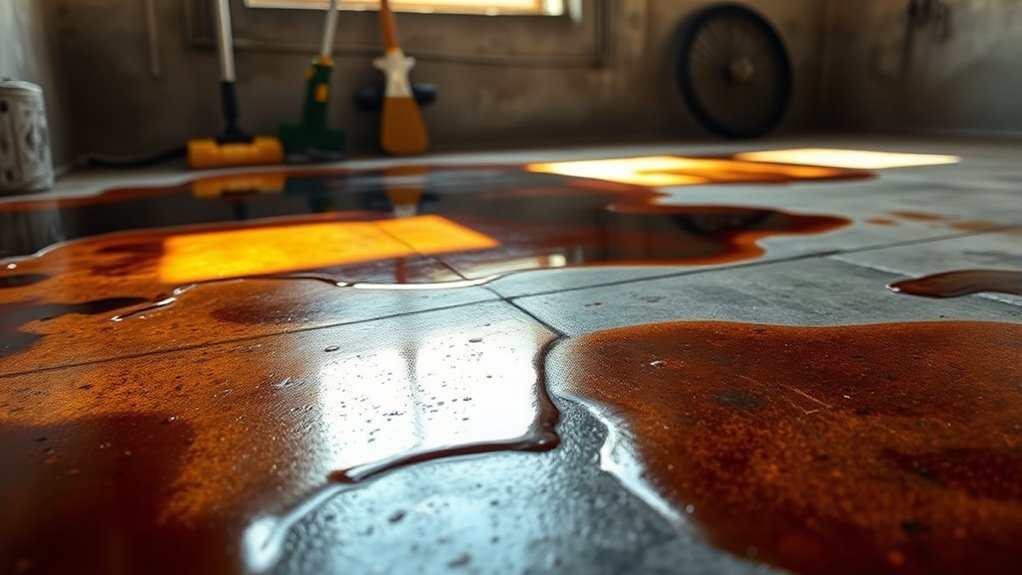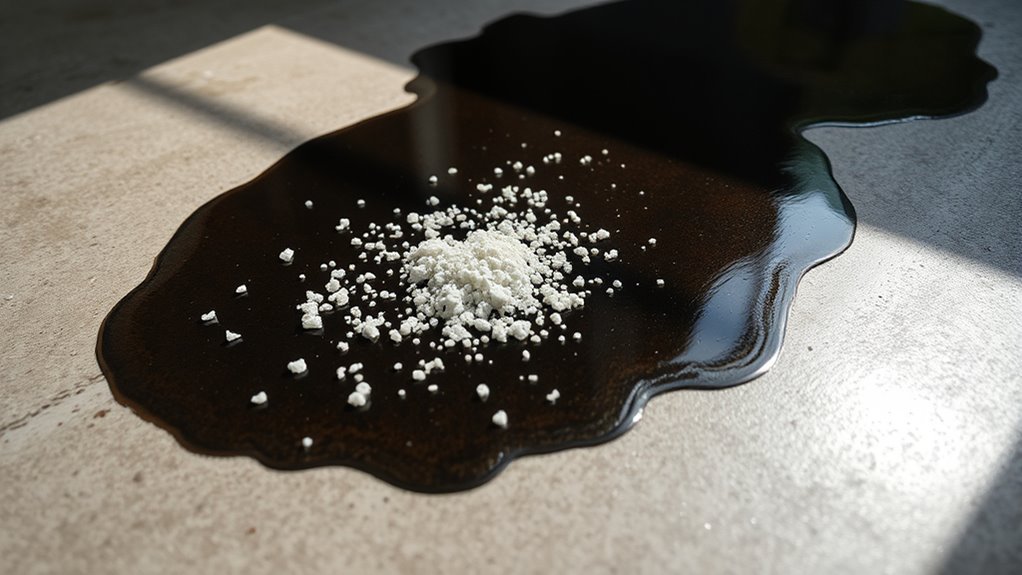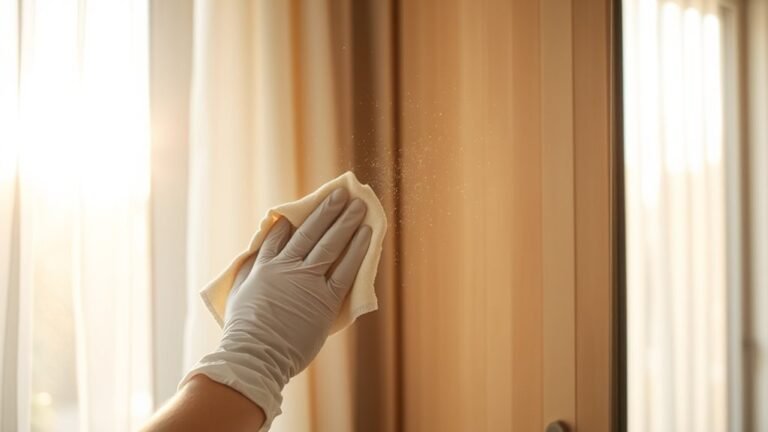How to Clean Oil Stains From Garage Floors
To clean oil stains from your garage floor, first identify the stain type and clear the area. Use absorbents like kitty litter or baking soda on fresh spills to soak up oil, then sweep it away. For older stains, apply a degreaser, let it sit, and scrub with a brush before rinsing thoroughly with water. Dry the floor completely to prevent slips. There are helpful tips for tougher stains and ongoing maintenance that can make your job easier.
Identifying the Type of Oil Stain

Before you tackle cleaning, it’s important to identify the type of oil stain you’re dealing with. Different oil types—motor oil, cooking oil, or grease—each leave distinct stain characteristics. Motor oil stains tend to be dark and slick, soaking deep into concrete pores, while cooking oil often appears lighter and more spread out. Grease stains are usually thicker and more stubborn, with a sticky texture that demands more attention. Knowing these differences helps you choose the right cleaning approach and avoid wasting time on ineffective methods. By recognizing the stain’s origin and nature, you gain control over the cleanup, freeing yourself from endless scrubbing and frustration. This understanding is your first step toward reclaiming a spotless, oil-free garage floor.
Gathering Essential Cleaning Supplies
Before you start scrubbing, make sure you’ve got the right cleaning agents that work well on oil stains. Don’t forget to grab protective gear like gloves and goggles to keep yourself safe. Also, prepare the necessary tools like brushes and absorbent materials to tackle the mess efficiently.
Choosing Effective Cleaning Agents
Although tackling oil stains might seem straightforward, choosing the right cleaning agents can make all the difference in how effectively you remove grease from your garage floor. You can opt for natural cleaners like baking soda, vinegar, or lemon juice—they’re eco-friendly and safe to use, giving you freedom from harsh chemicals. On the other hand, commercial products specifically designed for oil stains offer powerful grease-cutting abilities, ideal if you want quick and thorough results. When selecting, consider your preference for natural versus chemical solutions, the severity of the stain, and how much effort you want to put in. By picking the right agent, you take control of the cleaning process, making your garage floor spotless without unnecessary hassle or damage.
Selecting Protective Gear
A few key pieces of protective gear can make your oil stain cleanup safer and more efficient. First, slip on durable protective gloves to shield your hands from harsh chemicals and stubborn grease. Gloves give you the freedom to work confidently without worrying about skin irritation or contamination. Next, don safety goggles to protect your eyes from splashes or airborne particles during scrubbing. Keeping your vision clear and safe lets you tackle stains head-on without distractions. Choosing the right gear isn’t about limiting your freedom—it’s about empowering you to clean effectively while staying safe. With protective gloves and safety goggles, you’re ready to handle tough oil stains without risking injury, giving you peace of mind throughout the process.
Preparing Cleaning Tools
You’ll need five essential cleaning supplies to tackle oil stains on your garage floor effectively. Proper preparation is key—gathering the right cleaning tools guarantees you won’t get stuck halfway through. Here are four must-haves to start with:
- Absorbent materials like kitty litter or baking soda to soak up fresh spills.
- A stiff-bristled brush for scrubbing stubborn stains.
- A degreaser or heavy-duty cleaner formulated for oil removal.
- Protective gloves to keep your hands safe during scrubbing.
These preparation tips help you work efficiently and confidently, freeing you from mess and frustration. Having your cleaning tools ready means you can take control of your space and restore your garage floor with ease.
Preparing the Garage Floor for Cleaning
Before you start tackling those oil stains, make sure to clear the garage floor of any items and sweep away loose dirt and debris. This will give you a clean workspace and help your cleaning materials work more effectively. Once the area is ready, gather all the supplies you’ll need to get the job done right.
Clear and Sweep Area
Since cleaning oil stains requires direct access to the affected spots, you should start by clearing out any items from the garage floor. This step guarantees you have full freedom to work efficiently while observing safety precautions to avoid accidents. Next, give the area a thorough sweep to remove dirt and debris, which can interfere with stain removal.
Follow these steps to prepare your space:
- Remove all vehicles, tools, and storage bins.
- Sweep the floor with a stiff-bristle broom.
- Dispose of collected debris properly.
- Check the floor for any cracks or damage.
Gather Cleaning Materials
To tackle oil stains effectively, gather three essential cleaning materials: an absorbent agent, a degreaser, and scrub brushes. Start with something like kitty litter or baking soda to soak up fresh spills quickly. Next, choose a strong degreaser designed for concrete surfaces to break down stubborn oil residues. Finally, grab stiff-bristled scrub brushes to work the degreaser deep into the porous garage floor. These cleaning techniques not only help remove existing stains but also contribute to stain prevention by thoroughly cleaning the surface. Having these materials ready empowers you to act fast and keep your garage floor looking clean and free from unsightly marks. By preparing properly, you take control, ensuring your space stays functional and welcoming, reflecting your freedom to maintain it on your terms.
Using Absorbents to Remove Fresh Oil Spills

One of the quickest ways to tackle fresh oil spills on your garage floor is by using absorbents. Absorbent materials soak up the oil before it seeps deeper into the concrete, saving you from stubborn stains. Here’s how you can act fast and free yourself from the mess:
Act quickly with absorbents to soak up fresh garage oil spills and prevent stubborn stains.
- Grab absorbent materials like kitty litter, sawdust, or baking soda.
- Sprinkle a generous amount directly over the oil spill.
- Let it sit for 15-30 minutes to absorb the oil thoroughly.
- Sweep up the saturated absorbents and dispose of them properly.
Applying Degreasers and Cleaning Solutions
Although absorbents can handle fresh spills effectively, tougher or older oil stains often need a stronger approach. That’s where degreaser types come into play. You’ll find everything from citrus-based to enzymatic options, each designed to break down oil differently. Choose one that suits your preference for natural or heavy-duty cleaning. When applying, pour the degreaser directly onto the stain and let it sit for the recommended time—this helps loosen stubborn grime. Using proper cleaning techniques means avoiding dilution mistakes and ensuring full coverage without oversaturating your floor. Remember, patience here is key. By selecting the right degreaser type and following precise cleaning techniques, you regain control over your garage’s appearance, freeing yourself from the frustration of persistent oil stains.
Scrubbing Techniques for Stubborn Stains

A sturdy brush and a bit of elbow grease are essential when tackling stubborn oil stains on your garage floor. Effective stain removal depends on choosing the right scrubbing methods to break down tough grime without damaging the surface. Here are four key scrubbing tips to keep your freedom intact:
- Use a stiff-bristled brush to agitate the degreaser deep into the stain.
- Scrub in circular motions to evenly lift oil residues.
- Apply firm pressure, but avoid over-scrubbing which can wear the concrete.
- Work in small sections to maintain control and effectiveness.
Rinsing and Drying the Garage Floor
After scrubbing away the oil stains, you’ll need to rinse the garage floor thoroughly to remove any leftover degreaser and grime. Using effective rinse techniques, such as a garden hose with a spray nozzle or a pressure washer, guarantees all residue is washed away. Once rinsed, drying methods become key to prevent slippery surfaces and mold growth. You can let the floor air dry or speed up the process with fans or towels. Here’s a quick guide to help you master rinsing and drying:
| Step | Recommended Method |
|---|---|
| Rinse Option 1 | Garden hose with spray nozzle |
| Rinse Option 2 | Pressure washer |
| Dry Option 1 | Air dry |
| Dry Option 2 | Use fans |
| Dry Option 3 | Wipe with absorbent towels |
Preventative Measures to Avoid Future Stains
Taking a few simple steps can save you from dealing with stubborn oil stains down the road. Protecting your garage floor starts with applying preventive coatings that create a barrier against oil and other spills. But that’s not all—regular maintenance is key to keeping your space clean and stain-free. Here’s how you can stay ahead:
- Apply a high-quality preventive coating designed for garage floors.
- Clean up spills immediately to prevent seepage.
- Sweep and wash the floor regularly to avoid buildup.
- Place absorbent mats or drip pans under vehicles prone to leaks.
Frequently Asked Questions
Can Oil Stains Damage My Garage Floor Permanently?
Oh, sure, you might just love that stubborn oil stain adding character to your garage floor forever! But seriously, oil stain effects can be more than just an eyesore—they can actually degrade your floor’s surface over time. If you want to keep your garage looking sharp and avoid costly repairs, good floor maintenance is key. Don’t let those stains steal your freedom to enjoy a clean, well-kept space.
Is It Safe to Use Bleach on Oil Stains?
You might want to avoid using bleach on oil stains since it can damage your garage floor’s surface and isn’t the safest option. Instead, look into bleach alternatives like baking soda or kitty litter, which are gentler and effective. To keep your floor looking fresh, focus on oil stain prevention by quickly wiping spills and using absorbent mats. That way, you’ll maintain freedom from harsh chemicals and messy stains!
How Often Should I Clean My Garage Floor?
You should keep up with regular garage maintenance to avoid buildup and damage. The ideal cleaning frequency depends on how often you use your garage and what you store there. If it’s a high-traffic area or you often work on projects, cleaning every month or two is smart. Otherwise, a thorough clean every three to six months usually does the trick, giving you the freedom to enjoy a neat, well-kept space without stressing over constant upkeep.
Can Oil Stains Be Removed Using DIY Home Remedies?
Absolutely, you can tackle oil stains with DIY home remedies. Start by sprinkling baking soda over the stain to absorb the oil. Let it sit for a while, then scrub gently. Another trick is using a vinegar solution—mix equal parts vinegar and water, spray it on the stain, and scrub. These methods give you freedom from harsh chemicals and expensive cleaners, letting you refresh your space using simple, natural ingredients you probably already have.
What Should I Do if the Oil Stain Is Old and Set?
If you’re dealing with old stains, you’ll need tougher removal techniques since they’ve set in. Start by applying a strong degreaser or a poultice made from baking soda and dish soap, letting it sit longer to break down the oil. Scrub vigorously with a stiff brush, then rinse. You might have to repeat this process a couple of times. Don’t give up—you’ve got the freedom to restore your space!






